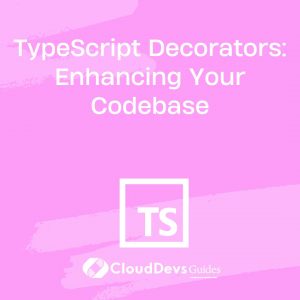TypeScript Decorators: Enhancing Your Codebase
TypeScript decorators are a powerful feature that allows developers to enhance their codebase by adding functionality and modifying behavior at runtime. Introduced in ECMAScript 2015 (ES6) and further extended in TypeScript, decorators provide a clean and elegant way to implement cross-cutting concerns, such as logging, authentication, and validation, without cluttering the core logic of your application.
In this blog post, we will explore the world of TypeScript decorators, covering their syntax, common use cases, and the benefits they bring to your projects. Whether you are a beginner or an experienced TypeScript developer, this comprehensive guide will help you unlock the full potential of decorators in your codebase.
1. Understanding TypeScript Decorators
TypeScript decorators are a form of declarative programming that allows you to modify the behavior of classes, methods, properties, and parameters by attaching metadata or additional functionality to them. Decorators are executed at runtime and can dynamically change the target they are applied to.
2. Decorator Syntax
TypeScript decorators are denoted by the @ symbol followed by the decorator function or expression. Decorators can be applied to classes, methods, properties, or parameters, depending on the desired effect. The decorator function is executed with different parameters depending on the target it is applied to.
typescript
function myDecorator(target: any) {
// Decorator logic here
}
@myDecorator
class MyClass {
// Class definition here
}
3. Creating and Applying Decorators
To create a decorator, you define a function that receives the target and optionally modifies it or adds metadata. You can then apply the decorator to a target using the @ symbol. Here’s an example of a simple decorator that logs a message when a method is called:
typescript
function log(target: any, propertyKey: string, descriptor: PropertyDescriptor) {
const originalMethod = descriptor.value;
descriptor.value = function (...args: any[]) {
console.log(`Calling ${propertyKey} with arguments: ${args}`);
return originalMethod.apply(this, args);
};
return descriptor;
}
class MyClass {
@log
myMethod() {
// Method logic here
}
}
const instance = new MyClass();
instance.myMethod(); // Logs: "Calling myMethod with arguments: "
4. Common Use Cases
Decorators can be applied to various elements of your codebase, offering a wide range of use cases. Here are some common scenarios where decorators can enhance your TypeScript projects:
4.1. Logging
Decorators can be used to automatically log method calls, providing insights into the execution flow and parameter values. By applying a logging decorator, you can avoid cluttering your code with repetitive logging statements and easily enable or disable logging as needed.
4.2. Authentication and Authorization
Decorators can add authentication and authorization checks to methods or classes, ensuring that only authorized users can access specific functionality. This approach centralizes security logic and promotes code reuse.
4.3. Caching
Decorators can implement caching mechanisms for expensive operations. By applying a caching decorator, you can transparently cache results and avoid redundant computations, significantly improving performance.
4.4. Validation
Decorators can validate method arguments or object properties, ensuring that they meet specific criteria before execution. This helps enforce data integrity and reduces the likelihood of runtime errors.
5. Class Decorators
Class decorators are applied to the constructor of a class and can modify its behavior or add additional functionality. They receive the class constructor as their sole parameter.
5.1. Property Decorators
Property decorators are applied to the declaration of a class property and can modify or enhance its behavior. They receive either the constructor function of the class for a static property or the prototype of the class for an instance property as their first parameter.
5.2. Method Decorators
Method decorators are applied to the declaration of a class method and can modify or extend its behavior. They receive either the constructor function of the class for a static method or the prototype of the class for an instance method as their first parameter.
5.3. Parameter Decorators
Parameter decorators are applied to the declaration of a function or method parameter and can provide additional metadata or modify its behavior. They receive either the constructor function of the class for a static method or the prototype of the class for an instance method as their first parameter, the name of the method, and the index of the parameter.
6. Decorator Composition
Decorators can be composed by applying multiple decorators to the same target. The order of execution is from bottom to top, with the decorator closest to the target being executed first.
typescript
@decorator1
@decorator2
class MyClass {
// Class definition here
}
7. Decorator Factories
Decorator factories are functions that return decorator functions. They allow you to configure decorators dynamically based on parameters or external factors. Decorator factories receive the configuration parameters and return the decorator function.
typescript
function myDecoratorFactory(config: any): ClassDecorator {
return function (target: any) {
// Decorator logic using the configuration
};
}
@myDecoratorFactory({ option: true })
class MyClass {
// Class definition here
}
8. Limitations and Best Practices
While TypeScript decorators provide powerful capabilities, there are some limitations and best practices to consider. For example, decorators cannot be applied to function expressions, only to the declaration itself. It is also recommended to use decorators sparingly and keep their logic concise to maintain code readability.
Conclusion
TypeScript decorators offer a versatile and expressive way to enhance your codebase by adding functionality and modifying behavior. From logging and authentication to caching and validation, decorators provide a clean and reusable approach to implementing cross-cutting concerns. By mastering the syntax, understanding common use cases, and following best practices, you can leverage decorators to create more maintainable and extensible TypeScript applications. Start exploring the world of decorators and unlock the full potential of your codebase today.
Table of Contents









